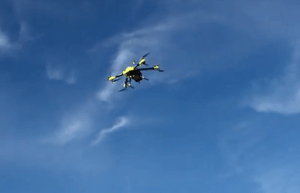 News and Opinion. While Amazon, Google, Walmart and other huge retailers are doing their best to publicize drone delivery, the idea has a PR problem. If drone delivery means having drones overhead all the time and loosening regulations to allow flight over people and down busy streets, the public argues, we don’t need it.
News and Opinion. While Amazon, Google, Walmart and other huge retailers are doing their best to publicize drone delivery, the idea has a PR problem. If drone delivery means having drones overhead all the time and loosening regulations to allow flight over people and down busy streets, the public argues, we don’t need it.
Even worse are those who see drone delivery as a threat to traditional trucking and delivery services. During discussion of the FAA Reauthorization Act last year, Senator Joe Manchin of W. Virginia opposed legislation to move drone delivery along. “West Virginia has lost enough jobs,” he commented, in a seeming non-sequitor.
But despite the abundance of news to the contrary, drone delivery is not mainly about getting burritos, pizza and Slurpees to a hungry public more quickly. A new study published by the Journal of the American Medical Association (JAMA) by Swedish researchers shows that drones can save lives by getting cardiac defibrillator equipment to patients more quickly.
The study, titled “Time to Delivery of an Automated External Defibrillator Using a Drone for Simulated Out-of-Hospital Cardiac Arrests vs Emergency Medical Services” concluded that drone delivery could be a valuable tool for increasing positive outcomes in cardiac arrest cases. Out of hospital cases of cardiac arrests (OCHA) have a statistically low survival rate of only 8-10%. “Reducing time to defibrillation is the most important factor for increasing survival in OHCA,” says the study. “Unmanned aerial systems, commonly called drones, can be activated by a dispatcher and sent to an address provided by a 911 caller…. Theoretical geographical information system models have shown that drones carrying an AED can reduce response times in rural areas.” Reduce those times by a lot, in fact – delivering the equipment far faster than an ambulance can arrive. And while it was tested in rural areas, it seems reasonable that residents of traffic-clogged cities like New York might see even more benefit.
The study was performed in cooperation with Swedish company FlyPulse, developers of life-saving drone technology. The company develops drones to deliver cardiac equipment, lifesaving drones for water rescues, and fire and incident review drones.
Cardiac defibrillation drones are not the only life-saving application of drone delivery. The first widespread and government-sponsored drone delivery program is taking place in Rwanda, where the government has partnered with drone delivery company Zipline to deliver blood supplies to remote clinics. Delivery company Flirtey has also tested ship-to-shore delivery of medical supplies, which could be a critical piece of disaster response programs; as well as delivery to medical clinics in the rural US.
While Amazon’s testing of retail packages and Google’s Project Wing tests of burrito delivery have garnered most of the attention, those are primarily means of testing UTM and safety concepts currently. Before widespread retail delivery is implemented, inaccessible areas may be able to utilize drones to deliver life saving medical supplies and equipment: and lawmakers at both a federal and local level should understand that before they decide that drone delivery isn’t necessary in their neighborhoods.

Miriam McNabb is the Editor-in-Chief of DRONELIFE and CEO of JobForDrones, a professional drone services marketplace, and a fascinated observer of the emerging drone industry and the regulatory environment for drones. Miriam has penned over 3,000 articles focused on the commercial drone space and is an international speaker and recognized figure in the industry. Miriam has a degree from the University of Chicago and over 20 years of experience in high tech sales and marketing for new technologies.
For drone industry consulting or writing, Email Miriam.
TWITTER:@spaldingbarker
Subscribe to DroneLife here.







Leave a Reply